Temperature Controller
Whether it's a bustling manufacturing facility, a cutting-edge research laboratory, or even in the comfort of your own home, temperature controllers ensure that processes run smoothly and efficiently.
In this captivating blog post, we will embark on a journey to explore the fundamental aspects of temperature control. Let's explore their multifaceted functions, diverse types, and expansive applications.
Function of a Temperature Controller
A temperature controller serves the purpose of regulating and maintaining a desired temperature in a specific environment. It accomplishes this task by continuously monitoring the current temperature and making necessary adjustments to the heating or cooling systems.
These controllers play a critical role in situations where temperature fluctuations can adversely affect product quality, safety, or overall performance.
Essential Components and Working Principles:
Temperature controllers consist of a few key components:
- The current temperature of the system is measured by a sensor, commonly a thermocouple or a thermoresistor.
- The temperature data received from the sensor is processed by the controller unit, which then compares it to the desired setpoint. Based on this comparison, the controller unit activates heating or cooling systems.
- The output device, a relay or a solid-state switch, regulates the heating or cooling elements by responding to signals from the controller unit.
Types of Temperature Controllers:
- There exists a type of controller known as the On/Off controllers. These controllers operate in a rather straightforward manner - toggling between an active and inactive state. The core principle of their functionality revolves around the detection of any deviation from the desired temperature setting. As soon as a disparity arises, these controllers act, either activating or deactivating the heating or cooling system accordingly.
- In contrast to on/off controllers, Proportional controllers adjust the heating or cooling intensity based on how much the temperature varies from the setpoint.
- PID controllers, known as Proportional-Integral-Derivative controllers, offer a more advanced method to adjust temperature. These controllers consider the current, past, and future deviations from the desired setpoint. As a result, they enable quicker and more precise temperature adjustments.
Applications:
Versatile Applications of Temperature Controllers Across Diverse Industries:
- The precise control of temperatures plays a pivotal role in upholding the calibre and uniformity of the end products.
- In the food industry, temperature controllers play a vital role in preserving and preparing various food items. From ovens to refrigerators, these controllers ensure that the optimal temperature is maintained for the safe handling and storage of food.
- Precise temperature control plays a crucial role in healthcare settings, particularly in laboratories and medical equipment. It is imperative for conducting experiments and storing delicate materials.
- Heating, ventilation, and air conditioning (HVAC) systems rely on temperature regulators to create and maintain a pleasant indoor environment. These systems are designed to ensure optimal comfort for individuals in various indoor spaces.
Conclusion:
During this era of technological innovation, the importance of temperature controllers cannot be overstated. These devices are vital in enhancing the dependability and efficiency of numerous processes across diverse industries.
Whether optimizing manufacturing procedures or safeguarding delicate materials, temperature controllers significantly shape our modern world. Stay tuned for more updates on the latest advancements in temperature control technology!
You Might Also Like: Can I run Ethernet and coax together?









